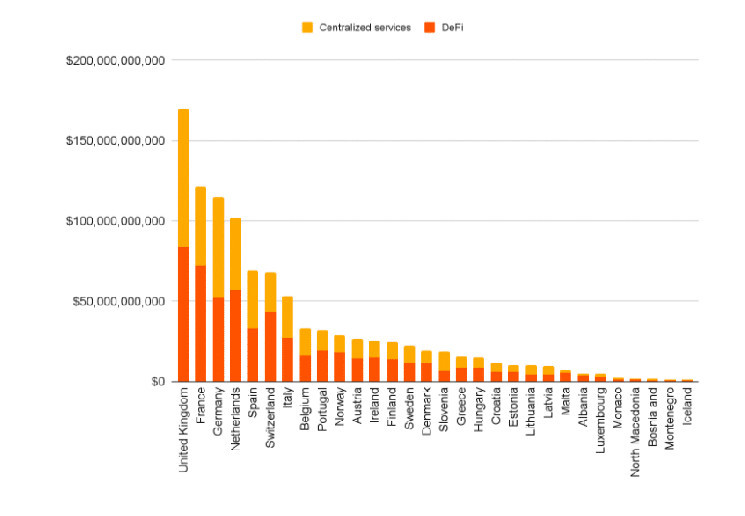- Dapp transaction volumes topped $270 billion, with Ethereum’s DeFi ecosystem accounting for 95% of them.
- DappRadar’s top Ethereum dapps have reached all-time highs. In 2020, high amounts of $13 billion and $11 billion were expected.
- 238 new DeFi dapps were submitted to DappRadar in 2020. The Ethereum blockchain is used by 106 (45%) of these.
DeFi became the driving force of the blockchain sector at the start of 2020. Other blockchains lacked developer support and composability, but Ethereum was ready for expansion. However, there were some red flags throughout this expansion.
COVID-19 kicked out in full force in mid-March, with the usual Markets and cryptocurrency values have both plummeted. Having a negative impact on MakerDAO’s DAI stablecoin’s $1 peg. MakerDAO was on the verge of collapsing, but the community rallied.
In 2020, yield farming was the second most important trend. The successful launch of Compound’s COMP coin, as well as the creation of an incentivization scheme, proved to be fantastic user acquisition tools.
Other DeFi dapps were fast to launch their currencies and reward actions, while others constructed meta protocols to optimise their profits. Other categories, such as NFT collectibles and games, followed suit over time.
Decentralizing with full force
Overall, governance tokens made up the majority of tokens created in DeFi and NFT dapps. For starters, it allowed the community to engage in dapp decision-making. Second, the governance structure is a significant step forward in the direction of true decentralisation.
The craze for high-yield farming has drawn attention to a number of other challenges. User retention was one of them. The launch of the so-called vampire dapp SushiSwap shook Uniswap’s leadership, and the example revealed that user retention is a critical indicator for future success.
Scalability was another issue that propped up during 2020. It happened because of the increasing activity in the Ethereum network. High gas prices impacted on low-value Dapps, particularly gaming, which went down over 90% between May and August. Thus an opportunity was developed for Ethereum focus Layer 2 solutions and rival Layer 1 blockchain.
There were many mergers and acquisitions that happened during 2020 which is likely to follow suit in 2021. The year 2020 was a watershed moment for the blockchain sector. Dapp transaction volumes topped $270 billion, with Ethereum’s DeFi ecosystem accounting for 95% of them.
Scalability issues
In 2019, an increasing number of new decentralised applications (dapps) were released across all blockchains. DeFi, NFT, and gaming dapps were the most important, all of which had a beneficial impact on activity in 2020. The majority of the action, as expected, took place on the Ethereum blockchain.
Dapps tried to grow as much as possible in 2020. Naturally, this had ramifications, such as rising Ethereum gas costs. The increased use of the Tether USDT stablecoin on Ethereum caused the first wave of price rises. This was compounded by activity from a number of high-risk dapps that were effectively spamming the network.
Next wave was yield farming that arrived in 2020. An average transaction cost more than $50.00 at its height. From a high-level perspective, Ethereum has effectively reached a scaling wall. The introduction of Ethereum 2.0 has become even more critical, not just in terms of maintaining Ethereum’s leadership position, but also in terms of ensuring its existence.

Demand upswing in 2020
EOS and TRON were the major challengers to Ethereum’s dominance in 2019, and while these protocols produced significant activity in 2020, other initiatives such as Polkadot and Binance Smart Chain (BSC) have quickly gained traction.
Without a question, when the DeFi category exploded in 2020, both EOS and TRON were basically playing catch-up. TRON created what were essentially Ethereum clones, and these dapps began to attract a lot of interest. On a daily basis, the TRON DeFi network has over 17,000 distinct active wallets.
EOS was a little slower, and outside of DeFi, other types of dapps are driving current activity. Despite this, the EOS DeFi ecosystem generates about 4,000 new active wallets per day. More Ethereum challengers are expected to emerge in 2020. Cardano, Polkadot, Binance Smart Chain, Cosmos, Near, and Flow are just a few examples. Although there are just a few projects functioning within these blockchains at the moment.
Binance Smart Chain (BSC) is the market leader in terms of new goods offered. Within three months of their inception, the top BSC dapps had amassed over 10,000 unique active wallets.
With 3,300 daily unique active wallets, PancakeSwap leads the BSC charge. Uniswap, the top Ethereum DEX, has a figure eight times lower. PancakeSwap is already earning more revenue than SushiSwap and Balancer, two other popular Ethereum dapps.
Other projects are still in the deployment stage, and Cardano recently announced the release of Liqwid, its first DeFi project. Cardano has yet to deploy smart contracts, but it is a strong rival, according to CoinGecko, as a top 10 project based on market capitalization.
Polkadot is on the verge of releasing an ecosystem to compete with Ethereum, despite the fact that no projects have yet been launched. The protocol has drawn the attention of the media and new investors such as KR1 and RockX, with RockX announcing a $20 million investment initiative to encourage Polkadot-based companies.
User retention
User retention was also shown in a new perspective by 2020’s rapid growth. As previously said, unique active wallets engaging with dapps smart contracts will be a significant metric of success in the long run.
In 2020, Uniswap was without a doubt the undisputed leader in the decentralised exchange (DEX) sector. Another enterprise, though, was waiting in the wings to try to displace it. SushiSwap is a service that allows you to swap sushi with other people. In mid-2020, the release of the so-called vampire dapp dominated headlines, since SushiSwap incentivize users to migrate liquidity from Uniswap.
 thecoinrepublic.com
thecoinrepublic.com